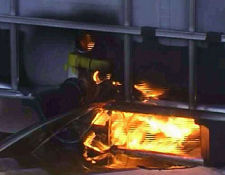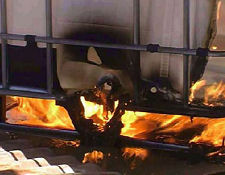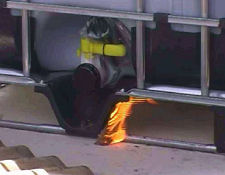News archive
Industry Overlooks Chemical Fire Risk |
| Posted on Aug 03 2008 |
| News archive >> OPINION |
|
|
| Initial small fire in a lubricant container |
 |
| Unignited oil begins to spread |
 |
| Rapid ignition of spreading pool |
In April 2002, a chemical plant in North Shields exploded in a blaze that took 300 fire fighters a full five hours to bring under control. More than 40 people were injured in the blast. At the heart of the explosion were several large and poorly protected plastic containers filled with flammable liquids – primarily paint thinner – that very quickly spread the fire.
The North Shields explosion wasn’t an isolated case. Intermediate bulk containers (IBCs), which are used to transport and store chemicals, have been involved in a number of large fires in recent years. One such fire in 2000 resulted in a toxic waste handling company in Gloucestershire being forced to pay £650,000 in fines and legal costs for putting public health and safety at risk.
These and other incidents have prompted the government to undertake extensive research into the use of IBCs. In 2007, the Health and Safety Executive (HSE) published a report on the safety of the containers, including a list of recommendations for minimising fire risk. Yet nowhere on this list is there any recommendation relating to the behaviour of on-site personnel.
Tests carried out by the HSE show that progress of a fire involving IBCs is likely to be rapid. Containers may hold more than a tonne of flammable or combustible liquid; once ignited, they yield their contents within a matter of minutes, forming large pools which then catch alight. But what the report fails to highlight is the danger this presents to those on-site. Because these pools won’t necessarily catch fire immediately, anyone in the vicinity of the release – not just fire fighters – is at risk of being trapped by liquids that may suddenly burst into flames.
Earlier this year, the Chemical Business Association and Solvent Industry Association published guidance intended to help its members address potential hazards related to storage of IBCs. The document outlines various appropriate measures, including partitioning IBCs to contain an initial explosion. It even makes recommendations for staff to be trained in dealing with leaks and spillages in the event of an emergency. It does not, however, plainly spell out the risks associated with them.
Anyone who may be at the scene of fire involving IBCs needs to be made acutely aware of the very real dangers they may face. But if risk assessments don’t make specific reference to the hazards associated with IBCs and pool fires, how can fire fighters and employees be expected to recognise them?
Even those working in well maintained areas may run the risk of being trapped by soon-to-be ignited liquids. Pools can spread fast, closing off exit points in storage areas where IBCs have been stacked with “adequate” space. Containers filled with edible oils can be particularly hazardous: in the event of a fire there is likely to be a delay before they ignite, meaning personnel can suddenly find themselves standing in pools of burning liquid.
Sign up for the ASK newsletter and receive more updates like these.
Images: HSE RR564
Last changed: Jan 20 2009 at 6:32 AM
Back
